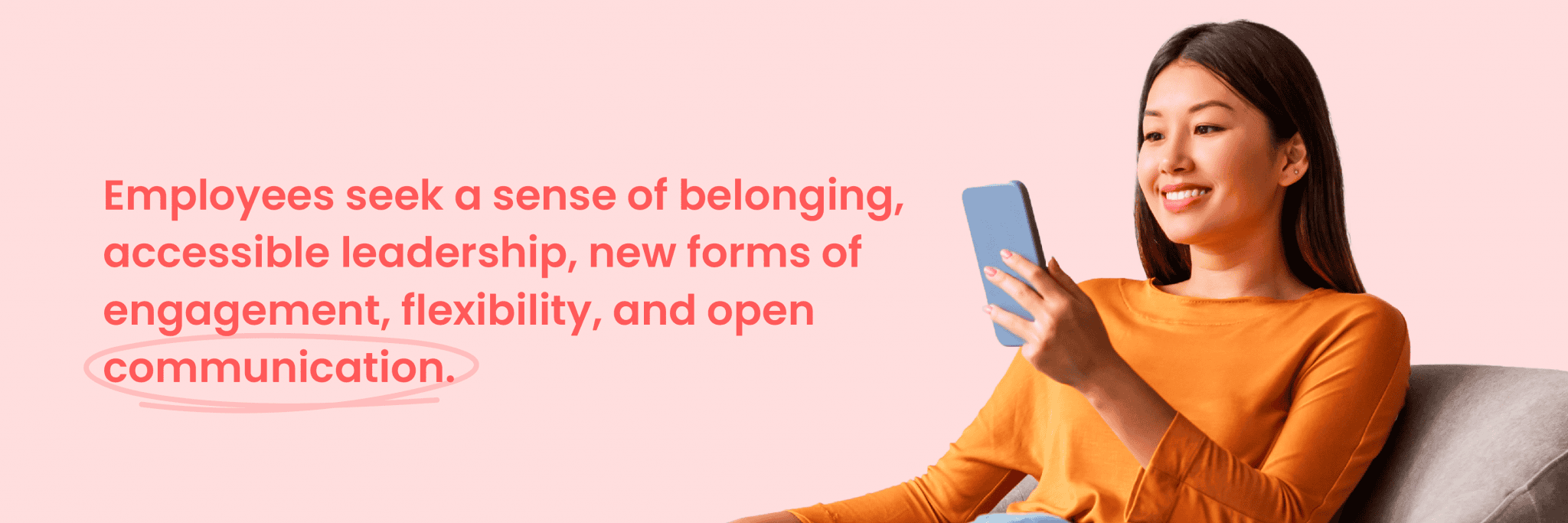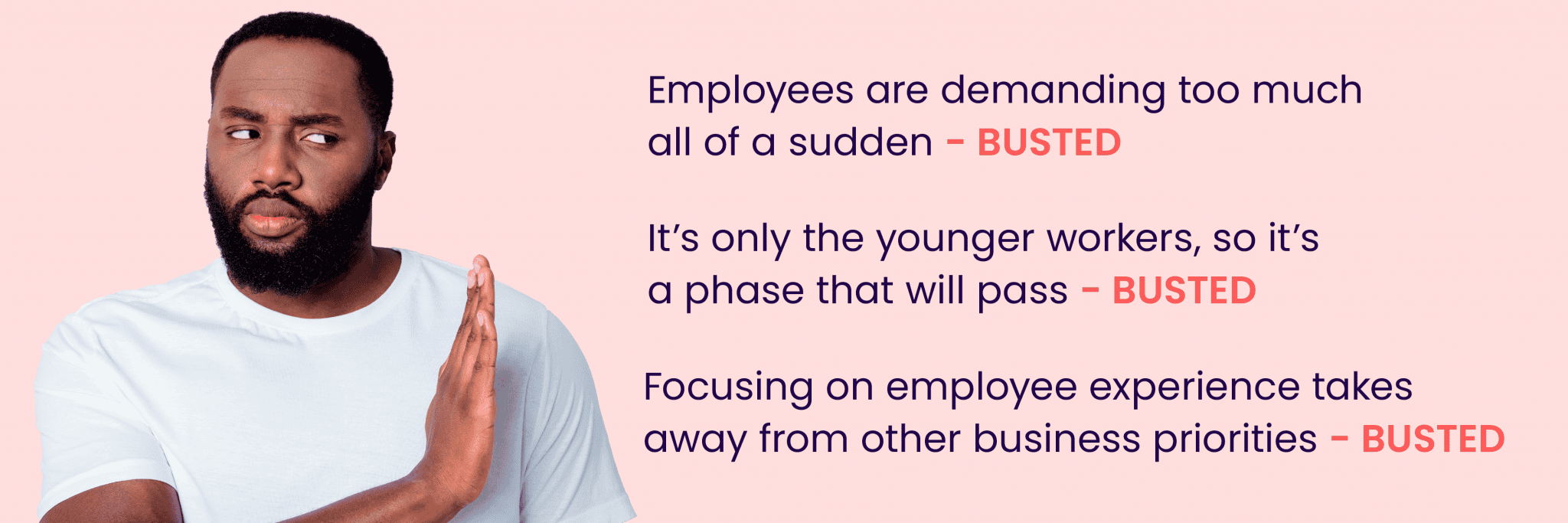Employee Experience Explained: The Truth Behind the Buzzword

Lisa Ardill
Content Editor at Workvivo
October 9 2022

Ever wondered what employee experience really means? Still figuring out how to differentiate it from HR? Ready to behold my Discovery-Channel-worthy myth-busting skills? You’ve come to the right place.
If people are your biggest asset (and trust us, they are), their experience while working for you is crucial to your company’s success. If humans are your most important resource (and the secret sauce of every successful CEO that ever wrote a book), then keeping your people happy, committed and motivated is key.
That’s why a positive employee experience is the most important lever in retaining talent, improving the customer experience, and boosting company performance.
Employee experience has become a bit of a buzzword in recent years, but it’s no passing fad. Despite reports of what some are calling the Great Regret, we’re still feeling the ripple effects of the Great Resignation – a mass exodus of people from their jobs the likes of which we have never seen before – such as quiet quitting.
And an employee’s experience is a key driver in whether they decide to stay or go (whether it be physically or mentally). In 2022, poor work-life balance and manager behavior are two of the top reasons people are choosing to quit.
So what actually is it? The employee experience hinges on what people expect from their workplaces. Historically, expectations have centered around salary, opportunities for career growth and professional development, and benefits like health insurance and a pension.

Now, workers expect more than the basics like bonuses and tokenistic treats like ping pong tables (does anyone actually like ping pong? Or am I just assuming hoping everyone else’s hand-eye coordination is as bad as mine?).
Their priorities have shifted; they want to be inspired and cultivate meaningful workplace relationships. That’s why human connection and compassion are so critical: employees seek a sense of belonging, accessible leadership, new forms of engagement, flexibility, and open communication.
The employers who step up in these areas are much more likely to have happier, healthier staff and, as a result, a much better chance at building a positive company culture, high productivity levels, and strong employee retention rates.
The alternative? A bunch of super stressed-out workers taking their frustrations out on a game of table tennis (with plenty of trash talk thrown in).

Research Monica shows that workplace stress can make your hair expand by up to six times its normal size
EX and HR: What’s the difference?
Is employee experience different from human resources? They complement each other, sure, but are by no means interchangeable. To deliver a great employee experience, employers need to have the right resources in place across three core workplace environments: physical, cultural, and technological.
While HR focuses on the resources – payroll to ensure wages are on time, Covid-19 forms to keep the office safe – employee experience zones in on the human element.
In short, HR is more about the resource while employee experience is more about the human. Delivering a great employee experience comes down to shaping safe but spectacular work environments for humans, rather than simply optimizing resources to get the most you can out of them.

Employee experience myth-busting
Why does it feel like employee experience is a hot topic all of a sudden? Cynics might see the conversation around employee experience as transient and simply a response to the emerging expectations of younger workers. (Newsflash: they’re wrong.)
But there are a few things we know. Firstly, the pandemic has pushed people to reconsider their priorities. They want a better work-life balance, more flexibility, and an employer that they can trust. That doesn’t seem too big an ask of the place where many of us spend the majority of our weeks.
And besides, employees have likely always wanted a workplace where they could be themselves, enjoy flexibility, and work autonomously – the difference is that they now feel more empowered to speak up about it.
Secondly, it’s not just Gen Z; these new priorities are popping up across generations. Today’s employees, whether they’re just out of college or closer to retirement, care about the experience their company gives them and won’t stick around for a negative one.
And thirdly, delivering a great employee experience is good for business. Employers who view these new priorities as demands and refuse to meet their people halfway are missing out on an opportunity to get ahead of the curve.
For maybe the first time, employees are telling companies exactly what they want. The ones that listen and take action are far more likely to flourish.
I’ll patiently await your praise for my Adam-Savage-level myth-busting skills, @ Discovery Channel.

Investing in employee experience
Just as HR impacts the employee experience, the employee experience affects how engaged your people are. Positive experiences that help employees feel safe, welcome, motivated, and heard are conducive to high engagement.
Workers who can’t see the impact of their work, who don’t receive recognition, and who can’t connect with their colleagues or the values of their employer are very unlikely to feel engaged. These are the people most at risk of quiet quitting or outright resigning.
That’s why it all comes back to human connection. If humans are the lifeblood of an organization, they need to get at least a little humanity back in return.
More than half of workers are psychologically unattached to their work and company and as a result, they’re more likely to leave. Investing in a more human employee experience that’s built on clear communication and a culture of appreciation and recognition is better for your bottom line.

6 hallmarks of a positive employee experience
A more human workplace – one that keeps employee experience and emotional connection at the top of its list – is trickier to achieve in a hybrid working world. But it’s very possible, particularly with the help of a platform that’s dedicated to employee experience, engagement, and internal comms.
1. Positive imprintable moments
Imprintable moments are the points in time where you leave a lasting impression on your employees. They span every part of the employee journey, from recruitment and onboarding to performance reviews and saying goodbye.
When done right, these moments reassure your people that they’re in the right place. Treating someone who’s going through a difficult time in their personal life with respect and compassion, for example, helps them feel safe and supported. And supporting your staff is what sets them up for success.
When done wrong, the results speak for themselves. 20% of staff attrition takes place in the first 45 days of new hires joining a company, and this has a knock-on effect on your recruitment budget, reputation, and the capacity of your teams.
2. Compassionate culture
Compassion is one of the most important traits of a more human workplace. If your company culture doesn’t have compassion at the heart of it, it’s impossible to convince your employees that you really care about them beyond their impact on the bottom line.
In an organization that promotes a compassionate culture, employees know they’ll be treated with kindness and respect. You can show them this in various ways, whether it’s company-wide time off to prevent burnout, resources to help with wellbeing, fostering a culture of learning rather than punishment, or simply focusing on people’s strengths instead of their weaknesses.
3. Accessible leadership
Leaders who want to deliver a great employee experience make themselves accessible to their staff. As Chief Heart Officer Claude Silver told once told us, “a leader needs to first and foremost be available and accessible to their people”.

At Irish DIY retail company Woodie’s, access to a weekly CEO blog is an important part of the employee experience. Woodie’s CEO Declan Ronayne shares leadership updates directly with all 1,400 of his colleagues through the blog, and employees have a direct line if they want to make suggestions or voice feedback with HR.
4. An authentic sense of belonging
Employees want to belong in the place where they work. 60% of workers feel an emotional disconnect from their colleagues and company culture. If you want your employees to enjoy working at your company, empowering them to bring their whole selves to work and still feel like they can champion your organizational values is absolutely key.
An employee experience that offers safety and a sense of belonging will only work if it’s authentic. That’s why flashy perks simply won’t cut it if the culture isn’t right; emotional and human connection needs to be there from the start.
An authentic culture imbued with compassion, authenticity, and belonging is a great foundation for an exceptional employee experience.
5. Open, community-led comms
Accessible leadership is part of a wider workplace strategy called open communication. Traditionally, corporate communication has been hierarchical and top-down, meaning people outside of the C-suite don’t often get the chance to use their voice.
With open, community-led comms, the employee experience becomes much more inclusive. Conversations become two-way instead of closed off, showing employees that they’re invited to speak and can expect to be heard.
It also gives leadership a much better understanding of sentiment throughout the organization. What better way to learn how to improve your employee experience than by asking the employees themselves?

6. Investment in the right support tools
Delivering a great employee experience is clearly essential, but it can be daunting. Remember that you don’t have to do it alone. Technology is at a point where workers across an organization – whether they’re frontline, in the office, working from home, or hybrid – can enjoy a shared workplace experience built on culture and company values.
That’s where a social intranet focused on employee engagement like Workvivo makes all the difference, connecting every single employee across your company and serving as its digital heart. Book your demo to learn more.
We can guarantee that it probably won’t make your employees’ hair look like Monica Gellar’s during a high-stakes game of ping pong.